 |
 |
 |
Volcano Eruption in ChileIntroductionA volcano eruption in Chile caused the evacuation of 4,000 people living within a 20-km radius of the Calbuco volcano. There are many volcanoes around the world at the present time; in fact, 36 of them according to the second article. Something is up with our planet and it is not good.Note that I am simply sharing items of interest. That does not imply that I agree with everything presented. "And ye shall hear of wars and rumours of wars ... nation shall rise against nation, and kingdom against kingdom: and there shall be famines, and pestilences, and earthquakes ..." (Matt 24:6-7) Prophecy News - April 2015
Volcano Eruption in Chile
Evacuation after Calbuco volcano eruption in ChileApril 23, 2015 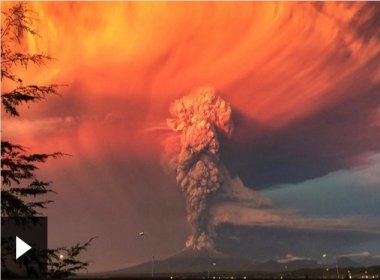 The Calbuco volcano in southern Chile has erupted twice in the space of a few hours - having lain dormant for decades. Footage from the area shows a huge column of lava and ash being sent several kilometres into the air. The authorities have declared a red alert and evacuated more than 4,000 people within a 20km (12 mile) radius. The Calbuco volcano is one of the most active in Chile, but its eruption took officials in the area by surprise. Alejandro Verges, an emergency director for the region, said Calbuco had not been under any special form of observation. Click here to read it allThe Number Of Volcanoes Erupting Right Now Is Greater Than The 20th Century's YEARLY AverageBy Michael Snyder, on April 16th, 2015 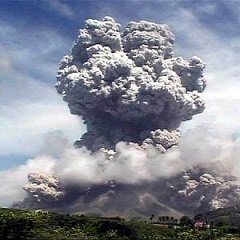 Is the number of volcanic eruptions worldwide increasing? Yes. During the 20th century, there were a total of 3,542 volcanic eruptions globally. That works out to approximately 35 eruptions per year. That may sound like a lot, but according to Volcano Discovery there are 36 volcanoes erupting around the world right now. In other words, the number of volcanoes erupting as you read this article is greater than the 20th century's yearly average. And all of this is part of a larger trend. In 2013, we witnessed the most volcanic eruptions worldwide that we had ever seen in a single year, and 2015 is already threatening to be another one for the record books. All over the planet, volcanoes that have long been dormant are beginning to wake up, and this is greatly puzzling many scientists. Fortunately, most of the eruptions in recent years have been relatively small. But scientists tell us that if we do see a VEI 7 or a VEI 8 eruption today, the amount of energy that would be released would be somewhere in the neighborhood of a million nuclear bombs going off all at once, and such an eruption would completely literally transform our civilization almost overnight. The last VEI 7 eruption that the world witnessed was in Indonesia in 1815. According to the Express, that massive eruption resulted in a "year without summer" and created famine all over the globe ... The deadly eruption of Mount Tambora in Indonesia sparked what was known as the 'Year Without Summer' in 1815 as crops failed and livestock died in much of the Northern Hemisphere - causing the worst famine for hundreds of years. However, academics have warned that the chances of a similar disaster happening in the next 85 years, which could see the Earth flung back into a "pre-civilisation state", was estimated to be as high as one in 10. Due to dense population, an eruption which killed tens of thousands only two centuries ago would now be "cataclysmic" for today's population, the authors warned. "Large volcanic eruptions have the potential to impact climate, anthropogenic infrastructure and resource supplies on a global scale," the panel of geologists, economists and climate scientists from the European Science Foundation have written in a new paper. If you don't think that such a thing could happen today, you should keep in mind that global food production is just barely keeping up with global food demand. In fact, in some years the world actually eats more food than it produces. Global food reserves are at perilously low levels, and so a "year without summer" would be absolutely cataclysmic. And right now, some of the biggest volcanoes in the world are starting to wake up. Click here to read it allEarthquake slams Nepal; devastating loss of people, historyBy Manesh Shrestha, Ray Sanchez and Don Melvin, CNN 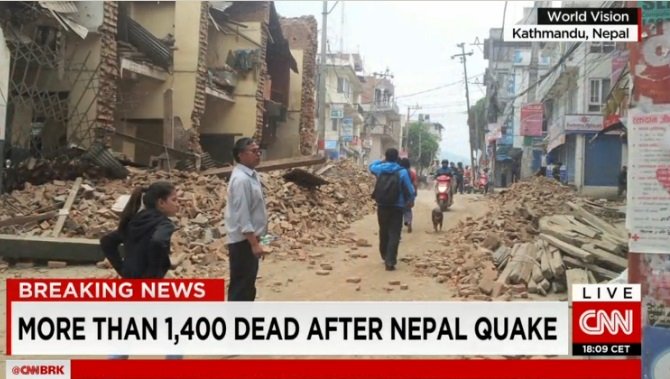 Kathmandu, Nepal (CNN)A magnitude-7.8 earthquake centered less than 50 miles from Kathmandu rocked Nepal with devastating force Saturday, toppling homes, temples and historic buildings and leaving at least 1,457 people dead, authorities said. Afterward, whole streets and squares in the nation's capital and largest city were covered in rubble. Stunned residents stared at temples that were once part of their daily lives and now were flattened to the ground. Locals and tourists ferreted through mounds of debris in search of survivors. Cheers rose from the piles when people were found alive, but mostly bodies turned up. The injured wound up being treated outside overflowing hospitals, where crowds of people gathered looking for relatives. Residents, terrorized by a seemingly endless series of aftershocks, huddled in the cold rain overnight for safety. Dozens of bodies were pulled from the nine-story Dharahara tower that came crashing down during the quake. At least 12 bodies were evacuated from a Mount Everest base camp hit by avalanches. Click here to read it allUS government says drilling causes earthquakes - what took them so long?US Geological Survey backpedals on previous research on wastewater fracking-induced earthquakes that have shaken eight states in last seven years 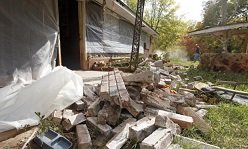 As the US Geological Survey confirmed on Thursday, in the last seven years, geologically staid parts of the US have seen earthquakes like they haven't seen for millions of years. And they were triggered by drilling for oil and gas. The drilling - or rather, the process of injecting water deep underground – has been triggering earthquakes in Alabama, Arkansas, Colorado, Kansas, New Mexico, Ohio, Oklahoma and Texas. The most obvious question is: what took you so long, USGS? Over those seven years, other scientists have speculated about whether this rise in earthquakes has anything to do with the injection wells used by the fracking industry to dispose of the water used in the process. For the most part, the report does not pin the blame on fracking itself - pumping large volumes of water, sand and chemicals into rock formations in order to free oil or gas - but rather on the associated process of injecting wastewater deep underground using injection wells. The rise of fracking after 2005's Energy Policy Act slightly preceded and coincided with the rise in earthquakes. Oklahoma averaged a handful of earthquakes of magnitude 3 or greater from 1975 to 2008. Then, in 2009, it had 20. Click here to read it allHow Many People Will Have To Migrate Out Of California When All The Water Disappears?By Michael Snyder, on April 2nd, 2015 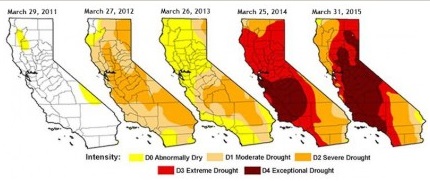 The drought in California is getting a lot worse. As you read this, snowpack levels in the Sierra Nevada mountains are the lowest that have ever been recorded. That means that there won't be much water for California farmers and California cities once again this year. To make up the difference in recent years, water has been pumped out of the ground like crazy. In fact, California has been losing more than 12 million acre-feet of groundwater a year since 2011, and wells all over the state are going dry. Once the groundwater is all gone, what are people going to do? 100 years ago, the population of the state of California was 3 million, and during the 20th century we built lots of beautiful new cities in an area that was previously a desert. Scientists tell us that the 20th century was the wettest century in 1000 years for that area of the country, but now weather patterns are reverting back to normal. Today, the state of California is turning back into a desert but it now has a population of 38 million people. This is not sustainable in the long-term. So when the water runs out, where are they going to go? I have written quite a few articles about the horrific drought in California, but conditions just continue to get even worse. According to NPR, snowpack levels in the Sierra Nevada mountains are "just 6 percent of the long-term average" ... Click here to read it allMass Whale Beaching Re-Ignites Quake Fears Among JapaneseTyler Durden on 04/11/2015  Six days prior to Japan's devastating 2011 undersea earthquake that killed over 18,000 people, around 50 melon-headed whales - a species that is a member of the dolphin family - beached themselves on Japan's beaches. Now, 4 years later, and despite a lack of scientific evidence linking the two events, many Japanese took to social media in fear as the mass beaching of over 150 melon-headed whales on Japan's shores has fueled fears of a repeat of the monster quake, which unleashed a towering tsunami and triggered a nuclear disaster. The mass beaching of over 150 melon-headed whales on Japan's shores has fueled fears of a repeat of a seemingly unrelated event in the country - the devastating 2011 undersea earthquake that killed over 18,000 people. Despite a lack of scientific evidence linking the two events, a flurry of online commentators have pointed to the appearance of around 50 melon-headed whales - a species that is a member of the dolphin family - on Japan's beaches six days prior to the monster quake, which unleashed a towering tsunami and triggered a nuclear disaster. The 2011 Japan earthquake is not the only instance of beached whales closely preceding a massive tremor. More than 100 pilot whales died in a mass stranding on a remote New Zealand beach on Feb. 20, 2011, two days before a large quake struck the country's second-largest city, Christchurch. Local officials said a total of 149 dolphins were found stranded on the beach in Hokota in Ibaraki prefecture, according to RT. Some of the dolphins, mostly melon-headed whales or blackfish, were found alive but were extremely weak. Click here to read it allFood Chain Catastrophe: Emergency Shut Down Of West Coast Fisheries: "Populations Have Crashed 91 Percent"Mac Slavo April 16th, 2015  Earlier this week Michael Snyder warned that the bottom of our food chain is going through a catastrophic collapse with sea creatures dying in absolutely massive numbers. The cause of the problem is a mystery to scientists who claim that they can't pinpoint how or why it's happening. What's worse, the collapse of sea life in the Pacific Ocean isn't something that will affect us several decades into the future. The implications are being seen right now, as evidenced by an emergency closure of fisheries along the West coast this week. On Wednesday federal regulators announced the early closure of sardine fisheries in California, Oregon and Washington. According to the most recent data, the sardine population has been wiped out with populations seeing a decline of 91% in just the last eight years. Meeting outside Santa Rosa, California, the Pacific Fishery Management Council voted to direct NOAA Fisheries Service to halt the current season as early as possible, affecting about 100 fishing boats with sardine permits ... The action was taken based on revised estimates of sardine populations, which found the fish were declining in numbers faster than earlier believed ... The council did not take Wednesday's decision lightly and understood the pain the closure would impose on the fishing industry, said council member Michele Culver, representing the Washington Department of Fish and Wildlife. She added that it was necessary because a new assessment of sardine stocks showed they were much lower than estimated last year, when harvest quotas were set. Source: New York Times via Steve Quayle / ENEnews Sardines, like honey bees, don't seem important to the casual observer. But just like honey bees, which are experiencing their own colony collapse, they are critical to the propagation of the global food chain. The immediate effects can be seen on the creatures next in line: ... 90 percent of this year's class of sea lion pups were starving for lack of sardines to eat. Click here to read it allYes! We have no bananas? It could actually happenYes! We have no bananas? It could actually happen Banana lovers take note: The world's supply of the fruit is under attack from a fungus strain that could wipe out the popular variety that Americans eat. "It's a very serious situation," said Randy Ploetz, a professor of plant pathology at the University of Florida who in 1989 originally discovered a strain of Panama disease, called TR4, that may be growing into a serious threat to U.S. supplies of the fruit and Latin American producers. "There's nothing at this point that really keeps the fungus from spreading," he said in an interview with CNBC. Click here to read it allIran, Saudi Arabia in tense buildup opposite Yemen's Gulf of Aden shore: US air tankers refueling Saudi jetsDEBKAfile Exclusive Report April 10, 2015, 8:30 AM Saudi-Iranian saber-rattling over Yemen has reached a dangerous peak, Thursday, April 9, the Saudi army spokesman, Brig. Gen. Ahmad Al-Assiri, warned: "Iranian ships have the right to be present in international waters, but won't be allowed to enter Yemeni territorial waters." This was Riyadh's rapid-fire riposte for the Iranian decision to deploy its navy's 34th Flotilla, consisting of the Alborz destroyer and the Bushehr helicopter carrier warship, in the Gulf of Aden opposite the Yemeni coast. The Saudi general noted that Iran had not evacuated any of its citizens from Yemen because, he said, "they are all involved in training and arming the Houthis." Soon after launching their air offensive in late March against the Iranian-backed Houthi rebels and forces loyal to ousted president Ali Saleh, the Saudis took control of the country's airspace to prevent the landing of airlifted Iranian supplies for the Houthis. Russian flights were also barred later from landing in the embattled country. Gen. Al-Assiri then issued Saudi Arabia's bluntest threat yet: "Those Iranians planning to remain in the country would face the same fate as the Houthis and their supporters," he said. Clearly, the Iranian Revolutionary Guards personnel were being trapped in a Saudi vice: Unable to leave Yemen, on the one hand, they were threatened with death if caught, on the other. Tehran decided to send its most effective naval force to the Gulf of Aden when it realized that Riyadh would not heed its warnings to back off Yemen. Its presence substantiated the threat of direct Iranian intervention in the Yemeni conflict should harm come to the elite IRGC force aiding the rebels. The Bushehr helicopter carrier made its maiden voyage to Port Sudan at the end of 2012. Shortly after that, on Dec. 8 of that year, debkafile first revealed its features: The new 13,000-ton vessel carries 12 Iranian strike helicopters, a crew of 200 and has a range of 8,000 nautical miles that reaches the US coast. There are five landing spots on its decks and four parking spots, as well as SM-1 and SAM anti-air missiles and 40-mm Fath-40 AAA anti-air cannon. Tehran invested $800 million in its first helicopter carrier. If Tehran is not scared off by the Saudi threat and does order the Bushehr to sail into Yemeni territorial waters, its guns and missiles would be in range there to strike targets in neighboring Saudi Arabia to the north. Tehran could justify this attack by Yemeni President Abd Rabbo Mansour Hadi having been granted asylum in the oil kingdom. However, the Saudi Air Force would also be on hand close by over Yemen to retaliate by bombing the Iranian Bushehr and other warships to chase them away from the Yemeni coast, if not to sink them. Our sources predict that this naval-air collision would likely be limited in extent. After peaking to a dangerous crisis, the clash would most probably be contained before it escalated into a full-blown war between Saudi Arabia and Iran. Military experts fear Saudi Arabia's strategy in Yemen is failingBy Christopher SnyderPublished April 23, 2015 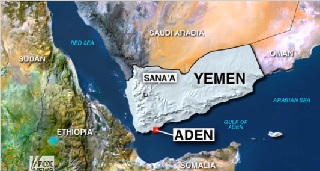 A Saudi-led coalition is keeping up an air campaign against Houthi rebel targets in Yemen, despite an announcement to end airstrikes. Riyadh is hoping these bombings will disrupt the Iranian-backed militants' network but, so far, rebels are still holding significant territory in the country, experts tell FoxNews.com. Air Force Col. Cedric Leighton (Ret.) and David Andrew Weinberg told Fox News' Jonathan Hunt that it has been hard to predict whether airstrikes against the rebels are working. "If the goal is just to get the Houthis to the negotiating table, then perhaps the airstrikes are working. Now, from a tactical, military sense because there apparently are some difficulties with the targeting the Saudis are using, I would then say the strikes are not working," said Leighton, a former Air Force intelligence officer. He added, "air power needs to be used in concert with other means of power - whether they be diplomatic, military on the ground, military maritime - those are the kind of things that make a difference." Strategic errors are a potential reason for Saudi Arabia wanting to end their air campaign. "The Saudis had made a couple missteps on their airstrikes ... it seems that they have bitten off more than they can chew diplomatically, in terms of what the optics of what the operation might look like," said Weinberg, a senior fellow with the Foundation for Defense of Democracies. He points out that while the coalition was able to strike military targets, they failed to put the deposed president, Abed Rabbo Mansour Hadi, back in office. There are growing indicators a full-scale sectarian conflict will break out between the former Sunni-led government and Shiite rebels. "The sectarian element of this conflict is very significant ... the Saudis have not shown themselves to be particularly concerned with power struggles between one faction or another in Yemen over the years," said Weinberg. "But when they see another Middle Eastern capital falling to Iranian, Shiite proxies, they have alarm bells going off." Even with a fleet of Iranian ships reversing course and returning home, both believe this conflict will remain a long-term issue for the region. "The underlining issues don't go away -- there might be a military truce, but nothing more than that is just going to paper over differences," said Leighton. "Saudi Arabia's King Salman said at the beginning of the campaign that the goal was to create a unitary, stable Yemen ... frankly, if that is his goal, he's guaranteed failure," said Weinberg. Click here to read it allIsrael reportedly hits Hezbollah, Assad targets in SyriaAl-Arabiya: IAF jets struck missile depots on Wednesday, Syrian army military bases near Lebanon border on Saturday  Israel reportedly hit several targets belonging to Hezbollah and the Syrian army in a series of air attacks Saturday morning in the Kalamun area on the border between Syria and Lebanon. According to a report in the Saudi-owned al-Arabiya, a first Israeli Air Force strike took place Wednesday, allegedly targeting two sites believed to have been Syrian army missile depots. On Saturday, according to a report in al-Jazeera, the Syrian targets were divisions 155 and 65 of the Assad army, in charge of "strategic weapons." Al-Arabiya reported that the targets were Scud missile depots housed in the military bases. Several explosions were heard in the areas of Kteife, Yabrud and a village in Kalamun, according to al-Jazeera on Saturday. The area is known as a Syrian military site housing weapons depots and installations. There was no official word from Hezbollah or the Syrian government on the alleged attacks. Israel is said to have targeted the same area in the past when it believed a shipment of advanced weaponry was being delivered from Iran to its Shiite proxy in Lebanon. Click here to read it allHomosexuals: Conservative Christianity Is Our Last Enemy To DefeatBy Charles M. Phipps on April 4th, 2015  Christian life in America is changing and not for the better. No, I will not say Christians are being persecuted in our country. Not yet, anyway. After reading of the treatment Christians are receiving in the Middle East from ISIS and other Muslim murderers, anyone claiming that Christians in America are being persecuted doesn't understand what true persecution is. Christians in America are not being persecuted, but they are most definitely being subjected to discrimination, harassment and prosecution, with almost all of it coming because of the Christian view that homosexuality is an abominable sin. Click here to read it allSigns That The Elite Are Feverishly Preparing For Something BIGBy Michael Snyder, on April 15th, 2015  What in the world are the elite up to? In recent days, we have learned that the New York Fed is moving a lot of operations to Chicago because of concerns about what a "natural disaster" could do, the federal government is buying 62 million rounds of ammunition commonly used in AR-15 semi-automatic rifles for "training" purposes, and NORAD is moving back into Cheyenne Mountain because it is "EMP-hardened". In addition, government authorities have scheduled a whole host of unusual "training exercises" all over the nation. So are the elite doing all of this in order to prepare for something really BIG, or should we just chalk up all of this strange activity to rampant government paranoia? First, let's talk about what the New York Fed has been doing. What kind of natural disaster would be bad enough to completely shut down the operations of the New York Federal Reserve Bank? It would have to be something very unusual, and apparently the New York Fed is very concerned that such an event could happen. According to Reuters, the New York Fed has been transferring personnel to Chicago and building up its satellite office there just in case a "natural disaster" makes it impossible for normal operations to continue in New York ... The New York branch of the U.S. Federal Reserve, wary that a natural disaster or other eventuality could shut down its market operations as it approaches an interest rate hike, has added staff and bulked up its satellite office in Chicago. Some market technicians have transferred from New York and others were hired at the office housed in the Chicago Fed, according to several people familiar with the build-out that began about two years ago, after Hurricane Sandy struck Manhattan. Officials believe the Chicago staffers can now handle all of the market operations that are done daily out of the New York Fed, which is the U.S. central bank's main conduit to Wall Street. This seems very odd. In all of U.S. history, there has never been a natural disaster in New York City that would have been bad enough to totally shut down the operations of the New York Fed for an extended period of time. So why are they so concerned? Well, I can think of one event that could cause such a disruption ... Click here to read it allDear Churches in America: Prepare to Be Treated Like 1st Century Christians in RomeBy Wallace Henley , Special to CP April 24, 2015|7:34 am The United States Supreme Court may soon liberate the biblically conservative church from old "prejudices" that should have long ago been "jettisoned," forcing it into "rightly bowing to the enlightenments of modernity," in the words of a recent writer in The New York Times. Homosexuality must be removed from the "sin list" and, according to an MSNBC commentator, traditional marriage proponents must be forced "to do things they don't want to do." Sadly, this crusade will be like the Marxist "liberation" movements that promised to "free" people, but really were about control and suppression. The culmination may come as the Supreme Court hears oral arguments on same-sex marriage cases beginning April 28. By July 1 the Court possibly will issue an official ruling regarding the constitutional right to homosexual marriage. The Court's decision may impact the form of biblically based churches dramatically. Churches that hold to a strict and conservative interpretation of the Bible's teaching about gender and marriage may find themselves "Romanized". The elites of first century Rome would not allow the church an institutional presence in society. "The Christian churches were associations which were not legally authorized, and the Roman authorities, always suspicious of organizations which might prove seditious, regarded them with jaundiced eye," writes Kenneth Scott LaTourette. In our time this means local churches that do not embrace same-sex marriage would find their legal status shaky or non-existent, as well as parachurch groups, conservative Christian colleges, church-based humanitarian agencies, and all other religious institutions - Christian and otherwise - supporting the traditional view of marriage. Without state-recognized corporate status everything from mortgages and building permits to employment and hiring practices is threatened - all of them essential for institutional function. Journalist Ben Shapiro notes that there is already a movement on the state level "to revoke non-profit status for religious organizations that do not abide by same-sex marriage." The Supreme Court's decision could make churches refusing to comply "private institutions engaging in commerce," and therefore subject to laws already in place. Refusal to perform a same-sex wedding would put a church out of business. Click here to read it allWIN/Gallup International: Israel one of least religious countriesApril 21, 2015  Israel is one of the least religious nations in the world, according to a recent WIN/Gallup International poll of residents of 65 countries around the world. According to WIN/Gallup International, 63 percent of respondents across the globe identified themselves as religious. While the Middle East was determined to be the most religious region on earth, with 86% of those polled describing themselves as religious, in Israel 65% "said that they are either not religious or convinced atheists, compared to just 30% who say that they are religious," WIN/Gallup International reported. Click here to read it allHere is a 10-minute video of some of the signs of the last days that happened around the world within the last month. Here are a few more images from the Calbuco volcano eruption in Chile: 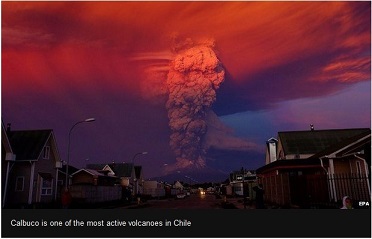 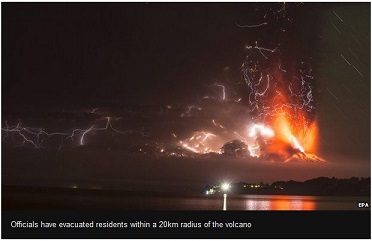 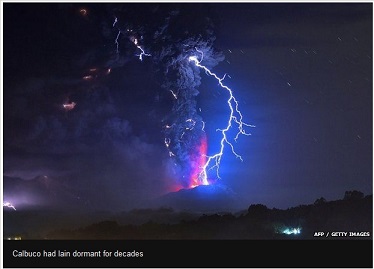 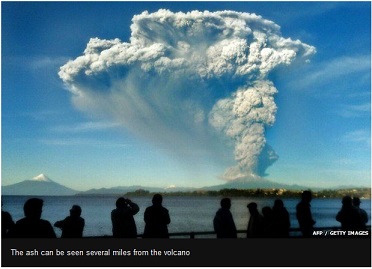 "And when these things begin to come to pass, then look up, and lift up your heads; for your redemption draweth nigh." (Luke 21:28) If prophecy of the end of the world is of interest to you and you would like to receive this monthly newsletter containing articles of interest and relevance to prophetic events, please respond using the form below: |
Prophecy Newsletter
Receive
free newsletters
reporting and analysing world events related to prophecy.
The Greek has multiple words for forgiveness? God forgives (charizomai) whether we ask or not. Receiving forgiveness (apheimi) is by our choice.
God always forgives!
|
|
|
|
||
|
| ||

New! Comments
Have your say about what you just read! Please leave a comment below.